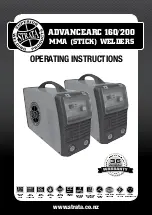
13
www.strata.co.nz
ADVANCEARC 160 • ADVANCEARC 200
Arc Rays can Burn Eyes and Skin
DANGER!
Arc rays from the welding process produce
intense heat and strong ultraviolet rays that
can burn eyes and skin.
1. Use a Welding Helmet or Welding Face Shield fit-
ted with a proper shade filter (refer AS 60974-
1, AS/NZS 1337.1 and AS/NZS 1338.1 Safety
Standards) to protect your face and eyes when
welding or watching. (See Filter Table on Page 20)
2. Wear approved safety glasses. Side shields are
recommended.
3. Use protective screens or barriers to protect
others from flash and glare; warn others not to
watch the arc.
4. Wear protective clothing made from durable,
flame-resistant material (wool and leather) and
foot safety protection.
5. Never wear contact lenses while welding.
Noise Can Damage Hearing
CAUTION!
Noise from some processes can damage hear-
ing. Use AS/NZS compliant ear plugs or ear
muffs if the noise level is high.
Work Environment Safety
DANGER!
Remove any combustible material from the
work area.
1. When possible, move the work to a location well
away from combustible materials. If relocation
is not possible, protect the combustibles with a
cover made of fire resistant material.
2. Remove or make safe all combustible materials
for a radius of 10 metres around the work area.
Use a fire resistant material to cover or block all
doorways, windows, cracks, and other openings.
3. Enclose the work area with portable fire resistant
screens. Protect combustible walls, ceilings,
floors, etc., from sparks and heat with fire re-
sistant covers.
4. If working on a metal wall, ceiling, etc., prevent
ignition of combustibles on the other side by
moving the combustibles to a safe location. If
relocation of combustibles is not possible, desig-
nate someone to serve as a fire watch, equipped
with a fire extinguisher, during the welding pro-
cess and well after the welding is completed.
5. Do not weld or cut on materials having a combus-
tible coating or combustible internal structure, as
in walls or ceilings, without an approved method
for eliminating the hazard.
6. After welding, make a thorough examination for
evidence of fire. Be aware that visible smoke or
flame may not be present for some time after
the fire has started. Do not weld or cut in atmos-
pheres containing dangerously reactive or flam-
mable gases, vapours, liquids, and dust. Provide
adequate ventilation in work areas to prevent accu-
mulation of flammable gases, vapours, and dust.
7. Do not apply heat to a container that has held
an unknown substance or a combustible mate-
rial whose contents, when heated, can produce
flammable or explosive vapours. Clean and purge
containers before applying heat. Vent closed con-
tainers, including castings, before preheating,
welding, or cutting.
Electricity Can Kill
DANGER!
Touching live electrical parts can cause fatal
shocks or severe burns. The electrode and work
circuit is electrically live whenever the output is
on.
The input power circuit and machine internal circuits
are also live when power is on. In semi-automatic or
automatic wire welding, the wire, wire reel, drive roll
housing, and all metal parts touching the welding wire
are electrically live. Incorrectly installed or improperly
grounded equipment is a hazard.
1. Do not touch live electrical parts.
2. Wear dry, hole-free insulating gloves and body
protection.
3. Insulate yourself from the work and the ground
using dry insulating mats or covers.




















